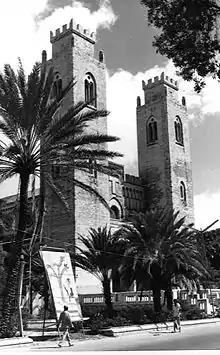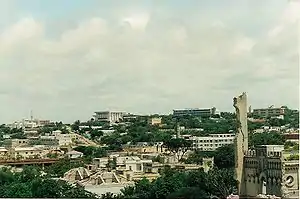Mogadishu Cathedral
Mogadishu Cathedral (Italian: Cattedrale di Mogadiscio) is a ruined Roman Catholic cathedral located in Mogadishu, Somalia. Between 1928 and 1991, it served as the seat of the Roman Catholic Diocese of Mogadiscio. Built in 1928 by Italian colonial authorities, much of the building was destroyed in 2008 by al-Shabaab. In 2013, the diocese announced plans to refurbish the building.
| Mogadishu Cathedral Cattedrale di Mogadiscio | |
|---|---|
 | |
| Religion | |
| Affiliation | Roman Catholic |
| Ecclesiastical or organizational status | Cathedral |
| Year consecrated | 1928 |
| Location | |
| Location | Mogadishu, Somalia |
| Geographic coordinates | 2°02′09″N 45°20′30″E |
| Architecture | |
| Style | Norman Gothic |
| Completed | 1928 |
History
Mogadishu Cathedral was built in 1928 by the Italian authorities in the former Italian Somaliland.[1] Known as the Cattedrale di Mogadiscio, it was constructed in a Norman Gothic style, based on the Cathedral of Cefalù, in Sicily. It was built in nearly six years by the Italian authorities in their former Italian Somaliland, in a central area of the capital not far from the Governor's Palace.
Indeed the Cathedral was built as the biggest in eastern Africa by order of Cesare Maria De Vecchi, a catholic governor of "Somalia italiana" who promoted the "Missionari della Consolata" christianization of Somali people.[2] It was built between 1923 and 1928 and was used as a model the "Cathedral of Cefalu" (in northern Sicily), created to commemorate the Christian reconquest of Sicily from the Arabs in the X century.
The Cathedral was done in "Norman" Gothic style, designed by architect Antonio Vandone. The facade, with an impressive appearance, was delimited to the sides by two towers, each 37.50 meters high. The plan of the building was a Latin cross; inside was divided into three naves separated by piers with pointed arches.[3]
The church was entrusted to the "Consolata" missionaries, then replaced by the Franciscans (Friars Minor). The altar had a huge statue -done by sculptor Cesare Biscarra- of the Virgin Mary of Consolata,[4] that looked at the parishioners in an impressive way like a statue of Roman Gods inside an ancient imperial temple.[5]
In 1989, on the eve of the outbreak of the civil war in Somalia, the last Bishop of Mogadishu, Salvatore Colombo, was killed by armed insurgents while celebrating Mass in the cathedral.[6]
Current situation

After 1991, the cathedral was no longer regularly used.[7] In late 2008, much of the Catholic cathedral was destroyed.[8]
A BBC correspondent later visited the site in 2012 and reported that some internally displaced people had formed tent settlements on the cathedral grounds. This was in stark contrast to the many new shops that had opened outside, where merchants, optimistic about the city's relative stability since the ousting of the insurgents, had begun to publicly advertise their wares again. The correspondent also mentioned that although the cathedral had structurally incurred considerable damage by having its roof blown off among other things, its walls were still erect, its elegant stone arches still in place, and the general atmosphere was one of serenity.[9]
In April 2013, after a visit to the site to inspect its condition, the Diocese announced plans to rebuild the cathedral in the future.[10]
See also
| Wikimedia Commons has media related to Mogadishu Cathedral. |
- Roman Catholicism in Somalia
- Christianity in Somalia
References
- Giovanni Tebaldi (2001). Consolata Missionaries in the World (1901-2001). p. 127. ISBN 9789966210234. Retrieved 2014-04-06.
- The Catholic missionaries of "Consolata" promoted by governor De Vecchi (in Italian)
- Religious ceremony inside the naves
- Statue & decorations inside the Mogadiscio Cathedral
- Image of the Virgin Mary over the Altar
- La fede negata, aricolo dell'"Avvenire"
- Morgan, Francis. Vacation Goose Travel Guide Mogadishu Somalia. Soffer Publishing.
- Articolo del Giornale, 3 ottobre 2008
- Somalia's Graveyard of Grand and Beautiful Buildings
- "AFRICA/SOMALIA - "I found signs of hope," said Bishop Bertin who has just returned from Mogadishu". Agenzia Fides. Retrieved 24 January 2014.
Bibliography
- Guida d'Italia del Touring Club Italiano. - Possedimenti e Colonie, Milano 1929, p. 757.
- D. Paladini. Omicidio a Mogadiscio - L'ultimo vescovo al crepuscolo della Somalia Paoline Editoriale Libri. Roma,2006

